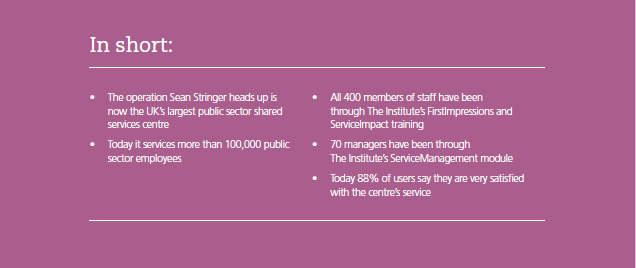Extract from Customer Focus Magazine: Issue 29 (May/June 2020)
There’s not much Sean Stringer, head of corporate customer services, Hampshire County Council hasn’t seen in his 15+ years working in customer service. The former contact centre manager, and head of executive customer services at Centrica, has been at the sharp-end of dealing with customer queries his whole career. All of which has been excellent grounding for giving him vital appreciation of the value of taking more of a learning centric approach to customer service, and in particular, through a programme with The Institute in his current role. “The job I do now is to head up the Customer Support Centre and Continuous Improvement functions for the UK’s largest public-sector shared services partnership,” says Stringer, who arrived in-post in 2017. “The Shared Services Partnership and its Integrated Business Centre launched in 2013, and provides finance, HR, payroll and recruitment services, initially for the three founding Hampshire partners – Hampshire County Council, Schools; Hampshire Constabulary and Hampshire Fire and Rescue Service. Over time the partnership has grown and added new public sector partners. Oxfordshire County Council and Schools joined in 2015 and three London Boroughs joined towards the end of 2018 – Hammersmith & Fulham, Kensington & Chelsea and Westminster.
While the model they run is intended to be self-service orientated for the 100,000+ public sector employees using it, in 2016 it was becoming clear it was under strain. He says: “We have around 400 staff that support the service and this includes queries that can’t be resolved through our online help (either by telephone, online enquiry form web-chat). These might include changing someone’s pay, authorising holiday, making recruitment approvals, or following up on the payment of invoice. But while there is always an expected level of customer contact that needs more attention than others, client feedback was such that the partnership took the decision to undertake a strategic review of the service.”
It was at this point that the shared services centre began working with The Institute. “We joined forces with its Insight Consultancy arm initially, to do a thorough assessment of our service model,” says Stringer. No stone was left unturned, with 2,000 key stakeholders interviewed. He says: “What the results revealed was substantiation of what we already suspected – that under-performance was undermining trust – but also that a strategic pathway was needed to solve it.” He adds: “The Institute actually put ourselves through its UK Customer Satisfaction Index criteria – and the results confirmed the noise we were hearing from customers and partners.”
In consultation with The Institute, it was decided that a comprehensive reset was needed to improve the centre’s service, engagement and satisfaction metrics. It was a three-pronged approach: to firstly improve the usability of the self-service portal itself (making it more intuitive); followed by upgrading the portal’s web-help – with much-improved tagging, so users could find the help they were looking for. Finally, and most importantly, was the third prong: a complete review of the customer contact operating model, with an important underlying people focus, which included partnering with The Institute’s Academy, to introduce defined learning programmes intended to support the cultural change required to support the ambition for the service, to put the customer at the heart of everything.
Stringer says: “In parallel with installing a new contact management system, introducing new channels, quality assurance guidelines and a complete revision of ways of working, we put staff through a major training programme. All regular staff were put through The Institute’s ‘FirstImpressions’ and ‘Service Impact’ training, while management went through its three day ‘ServiceManagement’ leadership module. Finally, all staff have the opportunity to enrol on The Institute’s Professional Qualifications stream or an apprenticeship. Training took place during 2018–19, and all 400 members of staff have been through the FirstImpressions and ServiceImpact training. Meanwhile, 70 managers have gone through the leadership module, while 17 people are currently studying for their Professional Qualification.
Stringer comments: “The whole point of the learning is to improve our people’s awareness of service – what it means, and how it can always be put front of mind, and we’re in no doubt that the initiative has helped consolidate and improve our service proposition.” He adds: “In 2017, one of the changes we made was to email every person we dealt with to rate our service – which means around 1,000 ‘snap surveys’ are returned to us every month. And the change we have noticed since implementing the changes and the training has been quite transformative, with 88% of customers across the partnership completing a survey satisfied with the service and over 80% highly satisfied with the service.”
Not content with this validation, the service centre has also undertaken The Institute’s ‘ServCheck’ barometer, and the Shared Services Centre now comes out with engagement scores higher than the national average. And finally – and this is the big one – its next set of Business Benchmarking results showed a 30 point increase on where it was before. “There’s a number of reasons we’ve improved,” argues Stringer. “The better upfront technology now means fewer calls come to call centre staff, but with them armed with the training they’ve received, they’re better able to service the people that do contact us.” This is evidenced, says Stringer, by its ‘right first time’ stats hitting 80%, a vast improvement on performance prior to undertaking the transformation programme. “What The Institute’s learning programme has done is enable us to keep our focus on putting the customer at the heart of everything we do,” says Stringer. “We play a vital role in enabling the crucial frontline services our partners deliver and by engaging our people in our vision and values through this training, we’ve really transformed ourselves.” He adds: “Our underlying mission working with The Institute, has also been to drive continuous improvement – to turn the insight we get from the independent surveys they provide, into tangible action. We record the type of service issues that most frequently come up, so that we can understand and divert investment, towards actual aspects of our service that need improving.” As well as ensuring there is insight on common issues, staff that do go above and beyond the call of duty are also rewarded too – with recognition for staff who score a perfect ten out of ten in snap surveys, for their timeliness and quality of service.
Of course there are some benefits from learning that can’t always be measured, but to anyone working there, there is an instinctive awareness that exists – and one of these benefits has been the all-important desire to change ‘culture’. Stringer says: “It’s quite clear people here now have a much greater awareness of their sense of service duty. The backbone of the learning is it always highlighting that customers are at the heart of what we do. In fact, one of the key features of both the management training and the first impressions training, is asking participants to come up with a service improvement idea of their own, and since we’ve run the training, hundreds of ideas have been presented – many of which have been implemented.” For their idea, one staffer scoped out an e-learning course on improving invoicing procedures, and this is now done by all staff, and all new joiners. “It’s clear that compared to where we were, and through working with The Institute, we are in a much better place than we ever were,” says Stringer. “So sought after is the FirstImpressions and ServiceImpact trainings, that we worked with The Institute to do a ’Train the Trainer’ exercise, to enable all further courses (including to new joiners) to be done in-house. The Institute will stay involved with management training and for accredited qualifications training, because it’s clear that it brings an expert view to service,” says Stringer.
He concludes: “Our whole ethos is to exist so that the people we support can get on with their own jobs with as little friction as possible. And if we can do this to the highest service excellence possible, then that’s all the better.” He adds: “We definitely feel we’ve achieved this. Sure, service improvement never ends, but through The Institute, we’ve really put ourselves in a position to ensure service stays our key priority.”

